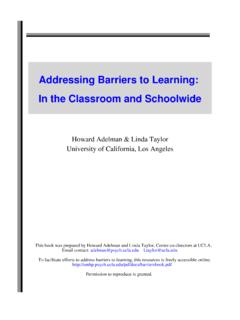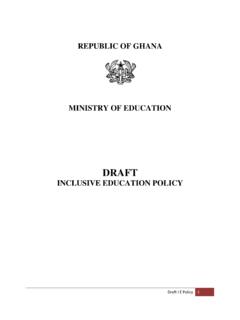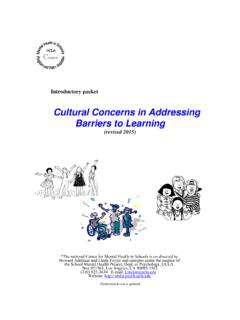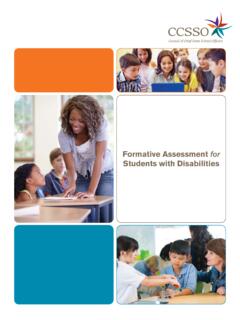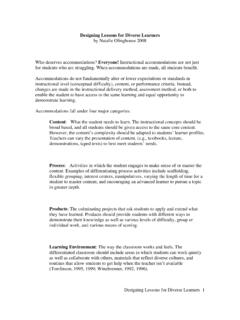Transcription of THE ROLE OF ICT IN OPEN AND DISTANCE EDUCATION
1 162 Turkish Online Journal of DISTANCE EDUCATION -TOJDE October 2014 ISSN 1302-6488 Volume: 15 Number: 4 Article 9 THE ROLE OF ICT IN OPEN AND DISTANCE EDUCATION Prof. Dr. Habibur RAHMAN School of Social Sciences, Humanities and Languages Bangladesh Open University, BANGLADESH ABSTRACT Open and DISTANCE learning is getting more dependent on information and communication technology (ICT) and has been playing an important role in the delivery strategies of DISTANCE learning . With the advancement in technology in the field EDUCATION has introduces variety of new techniques for educators and learners to enhance knowledge. Educational technologies (information and communication technology) are replacing direct teacher-student interaction. Anything that helps DISTANCE learners to communicate: learner with instructor, learner with learner and learner with the learning materials may be term as information technology.
2 Technological advancements especially in the area of ICT allow teachers to employ various strategies that could actively engage student s interest. This paper focuses the role of information and communication technologies (ICT) in open and DISTANCE EDUCATION . This study also explores technology-based media which is very important for DISTANCE learners. Keyword: Open and DISTANCE EDUCATION , technology, media and learning . INTRODUCTION EDUCATION is the basic need of every human being and today s technology has a big part in every sphere of life. In fact, EDUCATION is the most important investment by countries, societies, families and individuals for the future. A communication network has become an essential tool in today s educational environment than ever before. Today s society is said to have entered into the age of a new social revolution, information revolution . 21st century has witnessed the explosion of information technologies.
3 By digital revolution, technologies in computers, audio-visual devices, and communications are integrated into a powerful technology-information technology. The global era is characterized by rapid advances in technology and expansion of knowledge. Basically technology is nothing but a tool used in implementing our ideas and methodology in EDUCATION . 163 The application of new technologies in the DISTANCE EDUCATION context provides an appropriate starting point for delineating the knowledge base required of expert teachers in today s global society. Teaching the DISTANCE learners requires different skills to prepare relevant learning materials to facilitate the construction of knowledge and learning . The effective integration of ICT into the educational system is a complex, multifaceted process that involves not just technology- indeed given enough initial capital, getting the technology is the easiest part- but also curriculum and pedagogy, institutional readiness, teacher competencies and long term financing, among others.
4 Every country as they search for ways of using modern technology for educational purposes and development (Soh 2001). Open and DISTANCE EDUCATION providers in both developed and developing countries, have been quick to realize the potential applications of the new information and communication technology. It is well documented in the published literature and on Internet sites that on a worldwide basis the ICT an increasingly important role in EDUCATION and training. Furthermore, it has been demonstrated that the use of ICT can improve the quality of the student learning experiences and make EDUCATION and training opportunities available to a broader spectrum of the population in developing countries. At present educators are excited by the success of information technologies and want to implant them into instruction. They extol information technologies as the solution to break the barriers of time and space and fulfill the dream of life long EDUCATION .
5 METHODOLOGY The proposed paper mainly is descriptive-analytical in nature. Relevant books, articles and newspapers are used in this paper. Data and information are collected from the concern sources as per need to strengthen my research. Interpretative approach has been followed in this research. DISTANCE learning With the advancement in communication technology a variety of audio-visual media- radio, television broadcast, video cassettes, video compact disc, video text, CD, computer and other innovative techniques are used for effective transmission of knowledge to the learners at a DISTANCE and open learning system. Open and DISTANCE learning is the second chance for those who are not able to continue their studies due to certain reason. DISTANCE EDUCATION on demand has been a way of reaching students who are unable to attend a traditional classroom base course. Due to increasing pressure in higher EDUCATION , DISTANCE EDUCATION is a reality in the present world.
6 By definition, DISTANCE EDUCATION denotes an educational experience where the teacher and the learner are not face- to- face during the teaching and learning process. The word DISTANCE in itself denotes separation of isolation and hence the criteria of being isolated are a given in DISTANCE EDUCATION . 164 DISTANCE EDUCATION is planned learning that normally occurs in a different place from teaching necessitating special techniques of course design. Instruction, special method of communication by electronic and other media and special organization and administrative arrangements (Moore and Kearsley). Open and DISTANCE learning is defined by the Commonwealth of learning as a way of providing learning opportunities that is characterized by the separation of teacher and learner in time, or place or both time and place; learning that is certified in some way by an institution or agency; the use of variety of media including print and electronic; two way communications that allow learners and tutors to interact; the possibility of occasional face to face meetings; and a specialized division of labor in the production and delivery of course ( ).
7 Moore s(1989) definition of DISTANCE EDUCATION as, the separation between learner and teacher ,such that the communication between the two is necessary in the educational transition is transmitted through print, broadcasting, telecommunications media correspondence institution through the mail, audio and video recording, computers and various combinations and variations of these. DISTANCE EDUCATION - the delivery of learning or training to those who are separated mostly by time and space from those who are teaching training. The teaching is done with a variety of mediating process used to transmit content, to provide tuition and to conduct assessment or measure outcomes ( ). Nipper (1989) was the first to suggest that DISTANCE learning was moving into its third generation . Referring to correspondence EDUCATION as the first generation model of DISTANCE learning and multimedia DISTANCE EDUCATION as the second generation model.
8 In these models little or no student-student and student-teacher interaction occurs. Third generation of DISTANCE EDUCATION , also known as interactive, multimedia DISTANCE EDUCATION , places an emphasis on communication and learning as a social process typically through the addition of interactive media such as computer medicated communications, audio graphics or video conferencing. This third generation of DISTANCE EDUCATION is based on the use of information technologies (Pelton, 1991, Taylor, 1992). Taylor (1995) has further developed Nipper s ideas. With the combination of interactive multimedia (IMM) access to WWW resources, and asynchronous computer conferencing being designated as the fourth generation or Flexible learning model. The emerging fourth generation of DISTANCE EDUCATION , the Flexible learning Model, promises to combine the benefits of high quality interactive multimedia (IMM) with access to an increasingly extensive range of teaching- learning resources and enhanced interactivity through computer medicated communication(CMC) offered by connection to the Internet.
9 165 One of the strengths of the Multi-media Model of DISTANCE EDUCATION is that it has concentrated efforts on improving the quality of the student s individual interaction with learning materials. As Bates (1991) has highlighted that Social interaction between learners and teachers needs to be balanced with the individual student s interaction with teaching- learning resources including computer assisted learning program. USES OF ICT IN DISTANCE EDUCATION ICT are a potentially powerful tool for extending educational opportunities, formal and non- formal. ICTs also facilitate access to experts, resource persons, researcher, professionals, mentors, business leader, and peers- all over the world. For developing countries ICT have the potential for increasing access to and improving the relevance and quality of EDUCATION . ICTs stand for information and communication technologies are defined, for the purpose of this primer, as a diverse set of technological tools and resources used to communicate, and to create, disseminate, store and manage information.
10 These technologies include computers, the internet, broadcasting technologies (radio, television) and telephony (Victoria, 2002). This may include all types of learning technologies such as print, audio, video and the computer. The use of computers in open and DISTANCE EDUCATION has provided new pedagogical strategies in DISTANCE learning as well as giving more autonomy to the DISTANCE learners. Technology has become a part of our life on campus, at home, and in the office. The modern technologies used in open and DISTANCE learning are telephone tutoring, teleconferencing, audio graphics, video conferencing, computer conferencing drill and practice, fiber optics, teletext, and videotext, multimedia and hypermedia CAI, e-books, the Internet , the World Wide Web (WWW), or the Information Super Highway on-line database, on line discussion, call-in course- on demand, satellite, talk-back TV etc.










